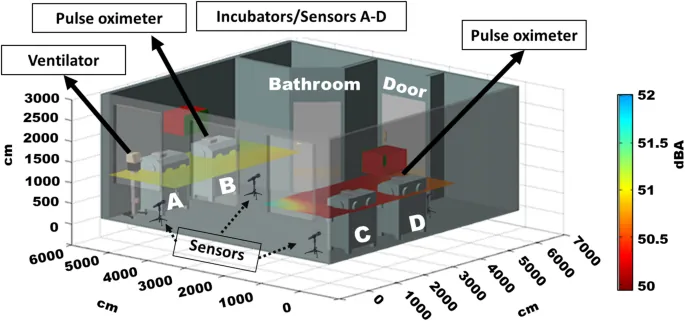
The Hidden Dangers of Noise in Neonatal Intensive Care: A Deep Dive into NICU Acoustic Mapping
2025-09-01
Author: Li
The NICU Noise Crisis: A Threat to Fragile Lives
In neonatal intensive care units (NICUs), sound can be a silent assassin. While these critical environments are designed to save the lives of premature and fragile infants, they often drown in harmful noise levels. Studies reveal that sound levels in NICUs regularly exceed the safety limits, with ranges from 57 to 97 decibels (dBA), significantly above the recommended guidelines of 20-40 dBA during the day and ideally closer to 10 dBA during rest periods.
Noise's Devastating Impact on Development
Preterm infants are particularly vulnerable to the barrage of sounds which can disrupt their still-developing sensory systems. Such acoustic overstimulation has been linked to severe consequences: disrupted sleep, stress regulation challenges, cardiorespiratory instability, and long-lasting cognitive impairments. Alarmingly, even with staff training and structured interventions, sound levels often remain dangerously elevated.
Architectural Factors: The Overlooked Element
Many factors influence the acoustic environment in NICUs, including their layout and materials. Innovative studies have shown how certain designs, like single-family rooms, can help lower noise but may lead to caregiver isolation. These findings suggest a pressing need for architectural redesign to better protect vulnerable infants from exposure to dangerous noise levels.
Groundbreaking Research and Practical Solutions
To tackle this pressing issue, a recent study implemented a sophisticated noise monitoring framework in a public NICU in Syria. Utilizing a network of spatial sensors, the research aimed to quantify sound pressure levels, distinguish the clinical events that elevate noise, and develop machine learning models to predict high-risk acoustic scenarios. This innovation could signal a shift toward proactive noise management in NICUs.
A Call for Action: Bridging the Gap
Despite the wealth of studies outlining the detrimental effects of noise in NICUs, there is a critical need for actionable strategies—especially in resource-constrained settings. The implications of excessive noise are profound; they do not merely represent discomfort but can severely impact long-term health outcomes for these vulnerable patients.
Understanding the Acoustic Environment: The Findings
Empirical data from the NICU in Syria indicated higher noise levels during routine hospital activities. Peaks were especially noted during alarm events, which far exceed the recommended sound limits by significant margins, emphasizing the urgent need for systems that could monitor and manage these acoustic environments effectively.
Technological Advances: Making Noise Playable
By harnessing machine learning algorithms and spatial data analysis, the study successfully classified various acoustic events, categorizing sounds based on their sources. This innovation could pave the way for real-time monitoring systems that alert staff to high noise levels, facilitate scheduling adjustments, and help create a safer auditory environment.
Transforming NICU Environments: An Ongoing Journey
The findings call not just for awareness but for an integrated approach—combining architectural redesign with intelligent sound-monitoring systems. Such measures could dramatically enhance the care environment for infants, reducing harmful noise exposure while maintaining necessary medical operations.
The Future of NICU Care: Where Technology Meets Compassion
Ultimately, the intersection of advanced monitoring technology, healthcare design, and compassionate care is essential for creating optimal NICU environments. With continued research and collaboration, we can protect our most vulnerable patients from the perils of excessive noise while promoting their health and development.


 Brasil (PT)
Brasil (PT)
 Canada (EN)
Canada (EN)
 Chile (ES)
Chile (ES)
 Česko (CS)
Česko (CS)
 대한민국 (KO)
대한민국 (KO)
 España (ES)
España (ES)
 France (FR)
France (FR)
 Hong Kong (EN)
Hong Kong (EN)
 Italia (IT)
Italia (IT)
 日本 (JA)
日本 (JA)
 Magyarország (HU)
Magyarország (HU)
 Norge (NO)
Norge (NO)
 Polska (PL)
Polska (PL)
 Schweiz (DE)
Schweiz (DE)
 Singapore (EN)
Singapore (EN)
 Sverige (SV)
Sverige (SV)
 Suomi (FI)
Suomi (FI)
 Türkiye (TR)
Türkiye (TR)
 الإمارات العربية المتحدة (AR)
الإمارات العربية المتحدة (AR)